Project details
Skill
Cost
Estimated Time
Installing a pedestal sink can add elegance and maximize space in a small bathroom. While the process requires careful planning and some plumbing know-how, it’s a project many homeowners can tackle with the right tools and guidance. This Old House plumbing and heating expert Richard Trethewey demonstrates the key steps to successfully install a pedestal sink.
Pedestal Sink Overview
“There’s something elegant about pedestal sinks,” says Trethewey. “They’re perfect for a half bath, where a vanity would overwhelm the limited space.”
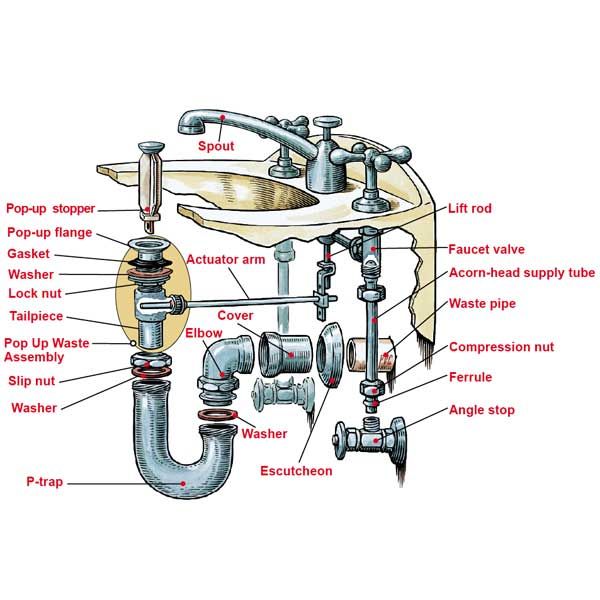
Because porcelain is so heavy, pedestal sinks are often made of two large, unconnected parts: the basin or bowl and the pedestal. When you lift the basin, the pedestal doesn’t come with it.
Pedestal sinks have an elegant appearance and a space-saving design ideal for small bathrooms or powder rooms. With fewer nooks and crannies than vanities, they’re easy to clean. Pedestal sinks are available in various styles to match different decor. According to Angi, you can install a pedestal sink in your bathroom for between $500 and $1,000.
Challenges of Installation
While pedestal sinks are visually appealing, they present some unique installation challenges. “This is the graduate school of do-it-yourself projects,” Trethewey says. Drain and supply pipes must be roughed in at the right height. Completed pipe work has to look neat. Then there’s the dreaded “tink”—the sound porcelain makes when a fastener is tightened too much—and the china breaks.
You’ll also be working in a very small space beneath and behind the sink. Trethewey often gets calls from homeowners who’ve been stymied by some critical step in the process. “You must measure, measure, measure,” he says. “Don’t rely on the manufacturer’s instruction sheet.”
Preparing for Installation
Before beginning the installation process, prepare your bathroom and gather the necessary materials.
Choosing Your Sink
Select a pedestal sink that complements your bathroom’s style and fits the available space. Choosing a sink that fits the height of the existing plumbing, particularly the waste pipe, will go a long way toward keeping costs down. Here are the main factors to consider:
- Compatibility with existing plumbing: Ensure the sink is compatible with your current plumbing setup. This includes matching the height and position of the waste pipe, as well as aligning with existing water supply lines.
- Faucet hole configuration: Confirm that the sink’s faucet holes match the type of faucet you plan to install. Different sinks accommodate single-hole, centerset, or widespread faucets.
- Material quality: Choose a sink made from durable materials like vitreous china, porcelain, or ceramic to enhance its longevity and add to your bathroom’s aesthetic appeal.
- Size and proportions: Select a sink that is proportionate to your bathroom space, ensuring it doesn’t overwhelm or underutilize the available area.
Gathering Tools and Materials
Ensure you have all the required tools and materials before starting:
- Basin wrench
- Bucket
- Caulk
- Crescent wrench
- Drill/driver
- Flux
- Hacksaw
- Lag screws and washers (usually not included with sink assembly)
- Lead-free solder
- Level (12-inch)
- Pipe wrench pliers
- Plumber’s putty
- Propane torch
- Tape measure
- Teflon tape
- Towels
- Tubing cutters (close-quarters or standard)
- Sandpaper
- Screwdrivers
- Socket wrench
- Water-pump pliers
Preparing the Bathroom
Take these steps to prepare your bathroom for the new sink:
- Shut off the main water supply to the old sink.
- Unscrew the hot and cold lines and drain them into a bucket.
- Unscrew the drain connection to the waste pipe.
- Remove the lag screws behind the basin with a socket wrench.
- If necessary, release the caulking between the basin and the wall.
- Lift the basin from the pedestal and remove the trap. Note that there may still be water in the trap.
- Remove the old pedestal or vanity.
- Clean any water off the floor.
Installing the Pedestal Sink
With preparation complete, you can begin the installation process. Since vitreous china is a fragile material and sinks are heavy, we highly recommend having a second set of hands to provide assistance when necessary.
Step 1: Checking the Waste Pipe
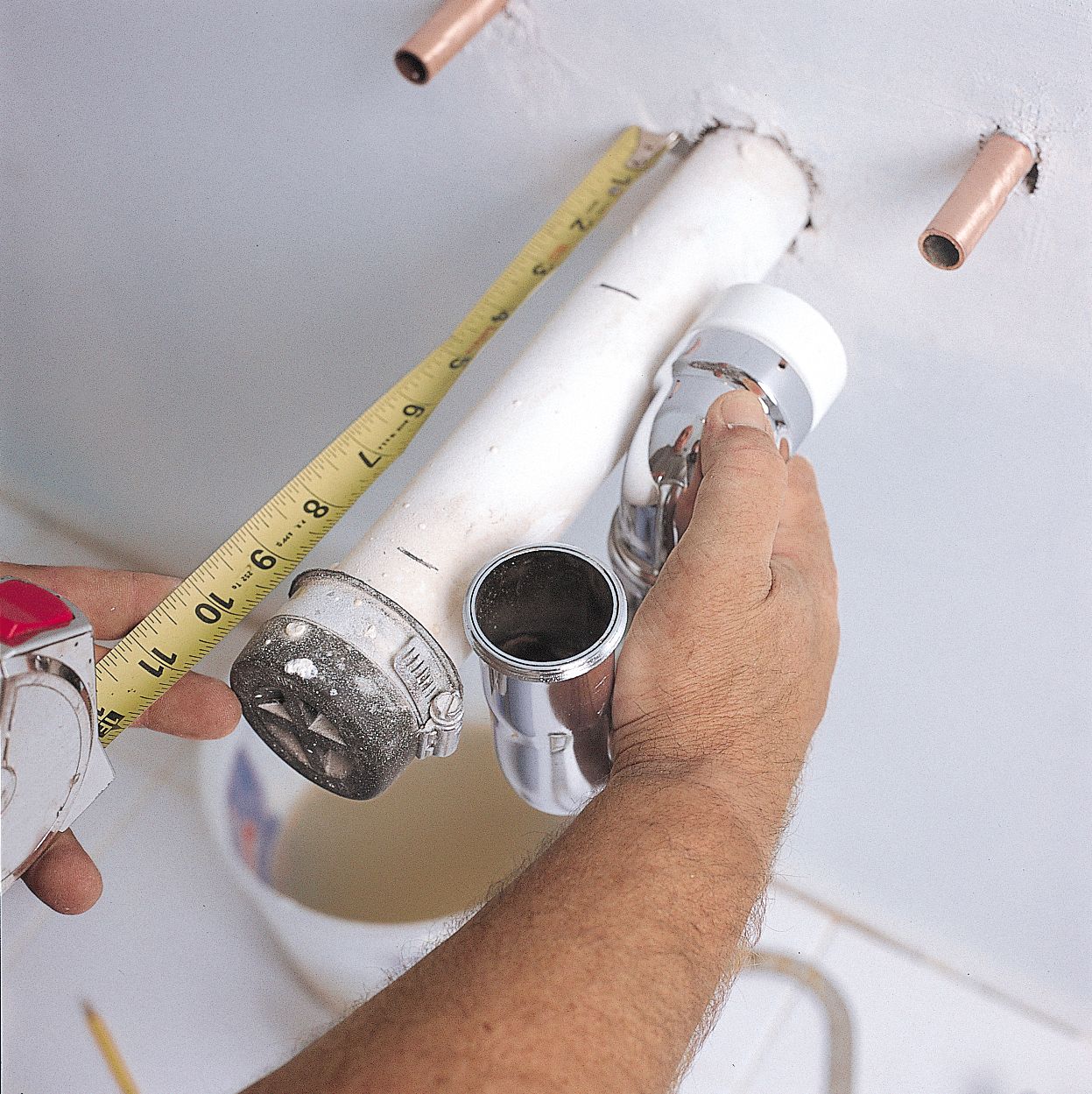
Pedestal sinks aren’t all compatible with existing plumbing for bathroom vanities. “More often than not, the existing waste pipe is too low to install the trap, which fits inside the pedestal,” Trethewey says. If this is the case with your new sink, you’ll need to call a licensed plumber to rough in a new waste pipe. Even experienced DIYers shouldn’t alter plumbing lines, or they could end up violating building codes and compromising their home’s value.
If the wall does need to be opened for plumbing work, install blocking, a horizontal 2×4 that’s screwed between the studs at basin height beneath the plaster or drywall. Blocking provides a solid anchor for the lag screws holding the sink against the wall.
Step 2: Prep the Rough-In plumbing
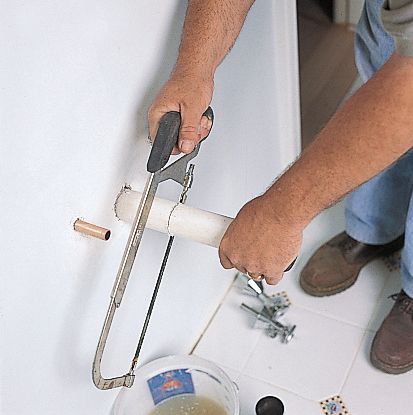
Once you’ve ensured the rough-in plumbing is at the right height, you’ll need to cut the pipes to fit the new sink. Always measure carefully before making any cuts, and follow the steps below:
- Use tubing cutters to shear off the copper supply lines about 2 inches from the wall. Tighten the cutter slightly after each turn around the tube to avoid distorting the soft copper.
- Measure the distance from the center of the basin’s drain to the wall. This measurement should be in the instructions, but double-check it yourself.
- Mark this distance (mark #1) on the PVC waste pipe.
- Hold the P-trap, fitted with its elbow, alongside the pipe with the trap’s vertical end centered on mark #1. A modern P-trap is recommended for proper venting and to prevent a gurgling bathroom sink.
- Make a new mark (mark #2) where the PVC shoulder joins the elbow.
- Cut the waste pipe at mark #2 using a hacksaw. For a square cut, hold the saw parallel to the floor and don’t apply downward pressure.
Step 3: Soldering the Supply Lines
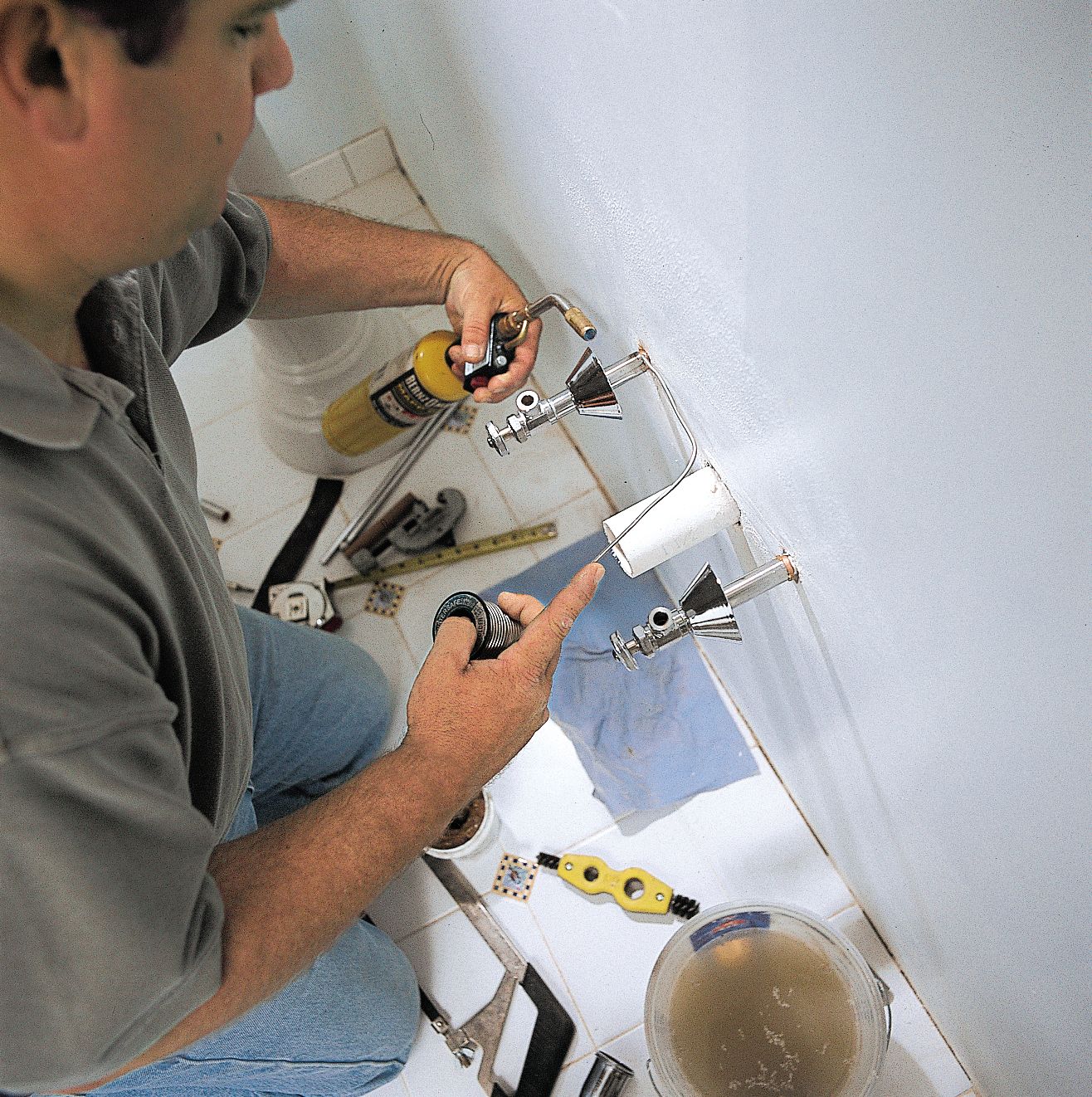
Preparation of the supply lines ensures a secure and durable connection to the new sink.
- Gently ream the inside edges of the copper supply lines with a pocketknife or the triangular blade on a tubing cutter. This removes the burr left by the tubing cutter.
- Polish the ends of the supply lines with sandpaper until the copper is shiny.
- Coat the line with flux. Polish and flux the inside of the angle stops and slip them, with their escutcheons, over the supply lines.
- Light the propane torch and apply its bright blue inner flame to the stop at the spot where the supply line ends. On the side opposite the flame, hold the tip of the lead-free solder against the copper tubing where it joins the stop.
- When the solder starts to melt, turn off the torch and run the solder around the joint.
- After the pipe cools slightly, wipe with a damp rag to smooth the exposed solder and remove any flux, which corrodes copper.
Step 4: Installing the Drain Assembly
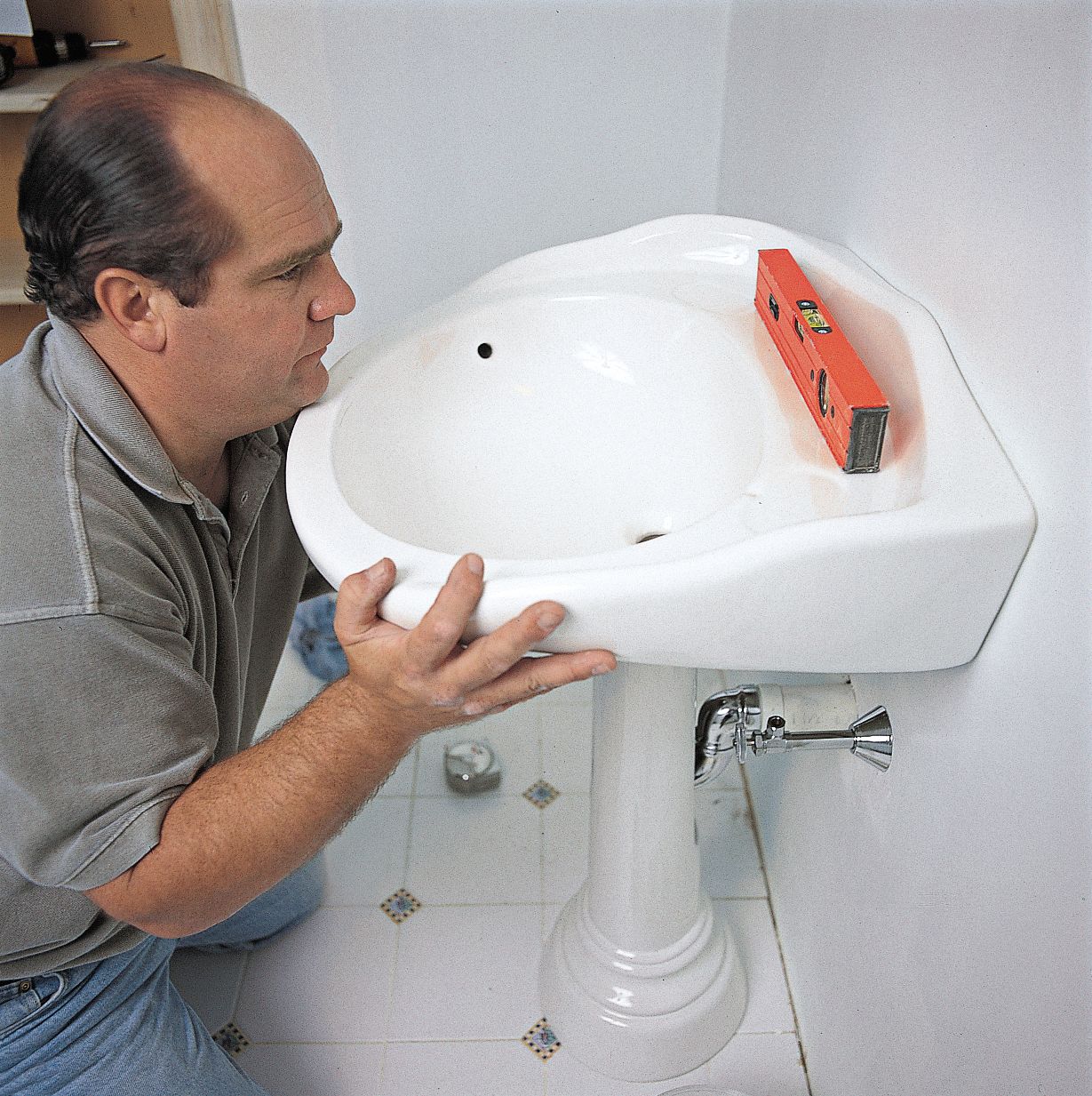
With the pipes prepared, it’s time to install the pedestal sink pop-up drain.
- Roll a wad of plumber’s putty into a ¾-inch-wide rope and wrap it around the pop-up drain beneath the flange.
- Wipe the basin hole clean and drop the pop-up drain into it.
- Attach the gasket, washer, and nut from underneath, hand-tightening first.
- Tighten the nut with a wrench or water-pump pliers with a quarter-turn, being careful not to overtighten.
Step 5: Leveling the Basin
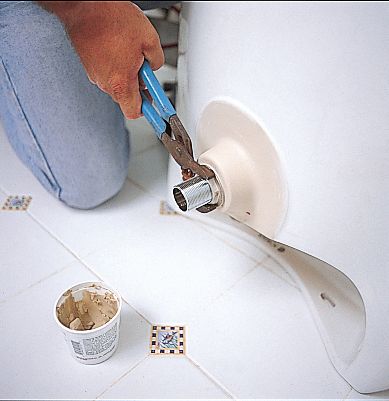
Taking an extra step to level and mark the basin will help ensure proper placement when the sink is mounted.
- Set the pedestal on the floor so it lines up with the PVC waste pipe and its center is about the same distance from the wall as the center of the basin’s drain (see Step 2: Prep the Rough-In Plumbing).
- Place the basin on the pedestal and against the wall. Fine-tune the pedestal placement, and level the basin side to side.
- Make a mark on the wall through each of the mounting holes at the back of the basin. This shows where to drill later for the lag screws that hold the basin to the wall.
Step 6: Attaching the Trap
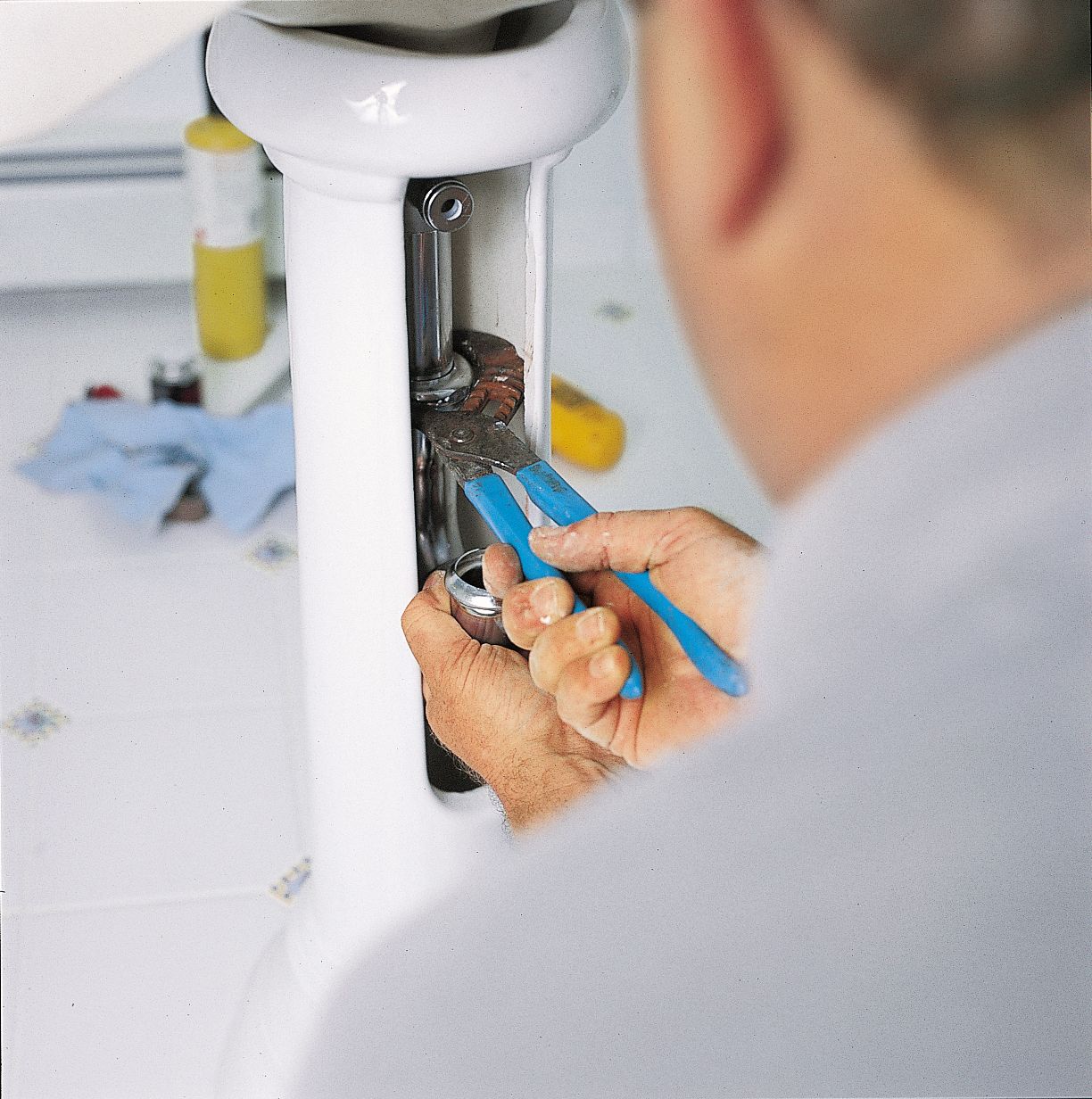
Keeping the pedestal and basin together, move them away from the wall. Have a helper hold the sink steady so it doesn’t tip over. Then you’ll be ready to install the trap by following the steps below.
- Test-fit the P-trap and elbow assembly to the PVC waste pipe. Measure the distance from the floor to the top of the trap’s open vertical end.
- Mark the same distance up from the floor on the tailpiece of the pop-up waste assembly.
- Remove the elbow and place the P-trap’s slip-nut and washer over the pop-up waste’s tailpiece.
- Cover the P-trap’s threads with pipe dope or plumber’s tape and slide the trap up to the mark you just made on the tailpiece. Thread the nut onto the trap by hand.
- Tighten the nut with a wrench or water-pump pliers, taking care not to mar the chrome finish.
- Drill into the wall at the lag screw locations marked in Step 5: Leveling the Basin.
Step 7: Mounting the Faucet and Sink
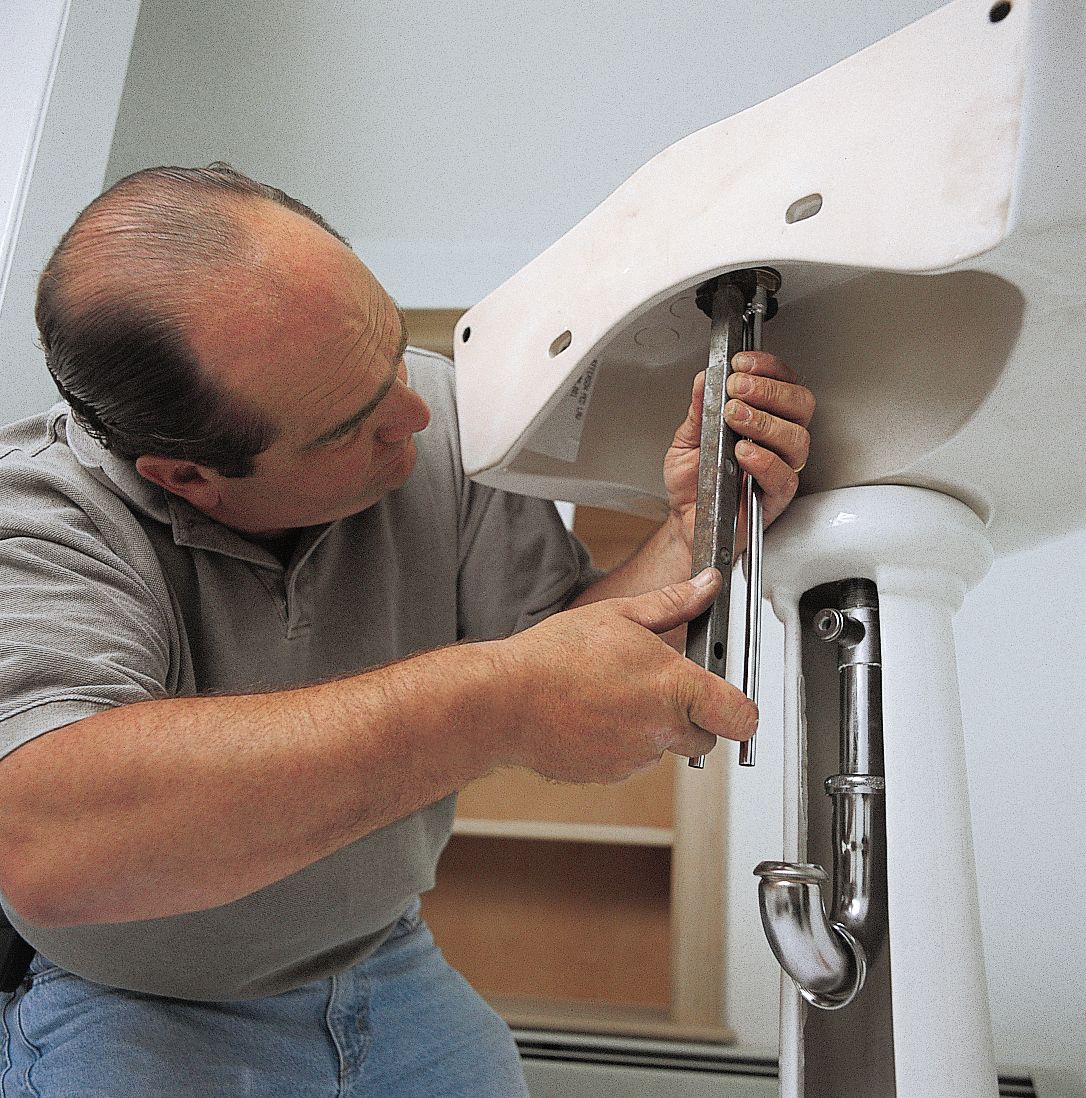
Careful handling is crucial when mounting the sink to avoid damaging the porcelain.
- Place O-rings (if provided) or rings of plumber’s putty under the flanges of the faucet’s valves and spout, and insert them into their respective holes on the basin deck.
- Slide a gasket and thread a nut onto the underside of each fitting. Tighten the nuts by hand, then finish tightening with a basin wrench.
- Carefully move the sink, both pedestal and basin, back against the wall.
- Line up the mounting holes in the back of the basin with the holes in the wall.
- Insert the lag screws with their fender washers through the mounting holes and tighten with a socket wrench while checking for level.
Step 8: Connecting the Plumbing

With the sink mounted, you can now complete the plumbing connections.
- Place a washer between the elbow and trap, dope the threads, and tighten the nut by hand. Finish tightening with water-pump pliers.
- Measure the distance between one angle stop and its faucet valve, add an inch, and cut a chromed supply tube to length with a tubing cutter.
- Slip two compression nuts and a ferrule over the cut end. First, tighten one nut to the stop with a wrench, then bend (don’t kink) the supply tube slightly—first to the side, then up—so its acorn head fits into the valve’s outlet.
- Tighten the head to the valve with the second nut. Repeat for the other angle stop and faucet.
- With the lift rod in the up position, attach the pop-up stopper to the actuator arm, then secure the arm to the lift rod with the screw provided.
- Slide the escutcheon and cover over the PVC waste pipe.
Pedestal Sink Installation: Finishing Touches

After the main installation is complete, a few final steps will ensure your new pedestal sink looks and functions properly. Ensure the sink is level and secure. Make any necessary adjustments, like aligning plumbing connections. Tighten connections if needed, but take care to avoid cracking the porcelain.
Testing for Leaks
Before considering the job complete, test the valves and check for leaks.
- Make sure the faucet valves are closed, then turn the main water supply back on.
- Remove the spout’s aerator and filter. Stand to one side and partially open one faucet valve.
- Let the water run for a minute to clear air and any debris. Repeat with the other valve.
- With the faucet shut off, check for leaks at all supply connections between the wall and the faucet’s valves.
- Reattach the aerator and filter.
Also check for any drain stopper leaks by activating the pop-up stopper and running water to make sure the basin fills.
Sealing and Caulking
Apply a bead of silicone caulk around the edges where the sink meets the wall and pedestal. This provides a finished look and prevents water from seeping behind the sink. Touch up any visible sealant or caulk. Clean the sink to ensure there is no leftover adhesive or residue that could cause a clog in the sink drain.
Our Conclusion
Installing a pedestal sink is a challenging DIY project that can enhance the look and functionality of your bathroom. Measure carefully, handle the porcelain with care, and take your time with the plumbing connections for the best results. Have an assistant nearby to help with moving and lifting, and call a licensed plumber if you need to make any alterations to the existing plumbing.
Tools
 Hacksaw
Hacksaw Propane torch
Propane torch level – 12-inch
level – 12-inch Pipe wrench pliers
Pipe wrench pliers Crescent wrench
Crescent wrench Close-quarters tubing cutter
Close-quarters tubing cutter Tubing cutter
Tubing cutter wire-brush pipe cleaner
wire-brush pipe cleaner Basin wrench
Basin wrench socket wrench
socket wrench Drill/driver
Drill/driver Slotted screwdriver
Slotted screwdriver Tape measure
Tape measure













